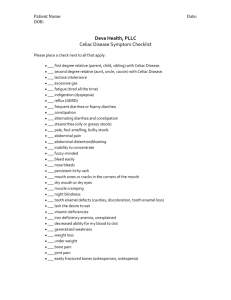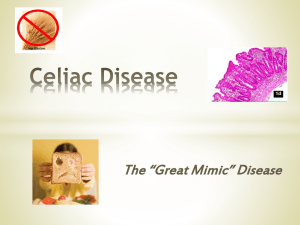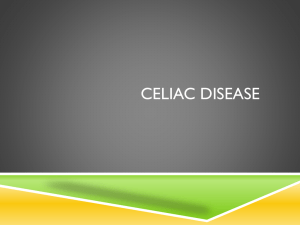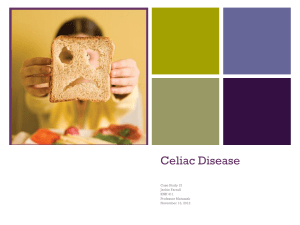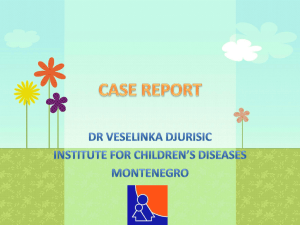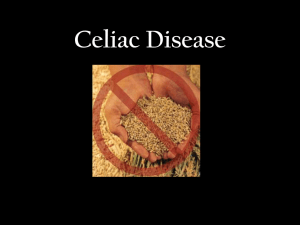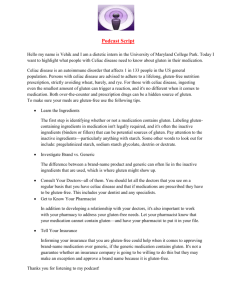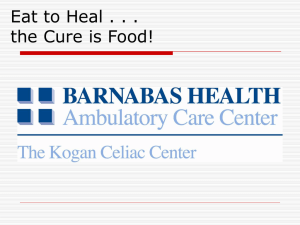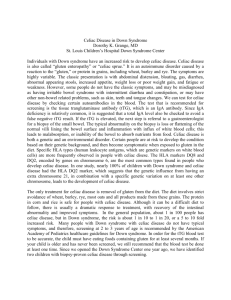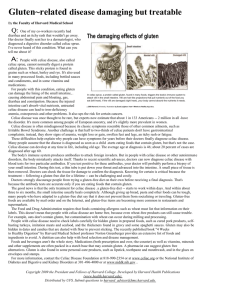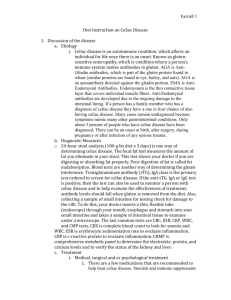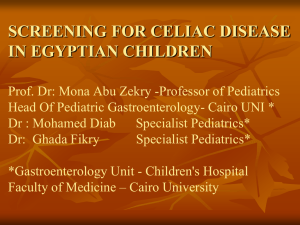Click here to see the Document
advertisement
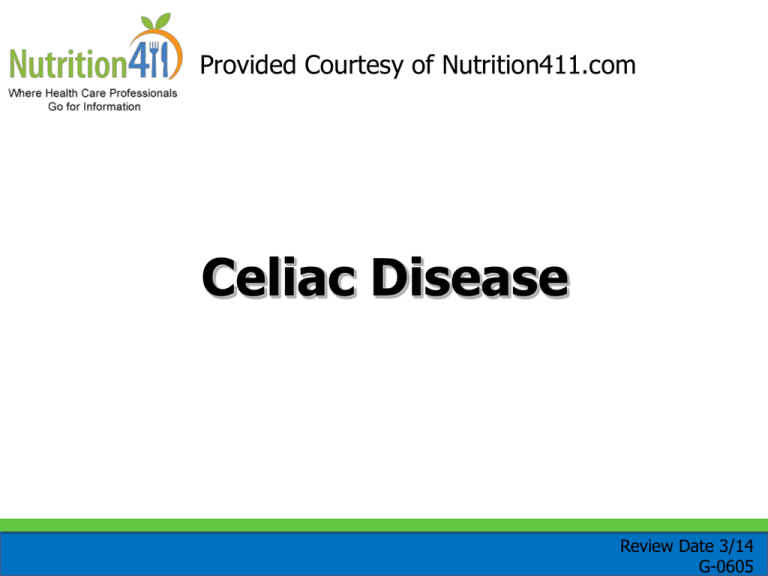
Provided Courtesy of Nutrition411.com Celiac Disease Review Date 3/14 G-0605 This presentation provides general information about celiac disease. Consult with your health care professional if you have any questions or for additional information, because each case is unique. What is Celiac Disease? • Characterized by four factors: – Genetic susceptibility – Exposure to gluten – Environmental “trigger” – Autoimmune response What is Celiac Disease? (cont’d) • No classic profile for celiac disease exists, unlike hypertension, cancer, or other diseases that have biomarkers • Often mistaken for Crohn’s disease, parasites, skin disorders, or other conditions • Trauma or stress may serve as the trigger Result of Celiac Disease • Intestinal villi (tiny “hairs” that help with nutrient absorption) are damaged by an inflammatory response to gluten • Malabsorption of nutrients results • Intestinal walls are more porous Symptoms • Diarrhea • Stools that float because they contain unabsorbed fat • Weight loss • Fatigue • Anemia Symptoms (cont’d) • Vomiting • Poor appetite • Dermatitis herpetiformis (itchy skin rash) Diagnosis • Serum antibody test: – Dietary changes alter results, so schedule evaluation before gluten is eliminated from the diet • Biopsy of lining of intestine to confirm diagnosis Associated Conditions • Iron deficiency anemia • Osteoporosis • Vitamin K deficiency associated with risk for hemorrhaging • Vitamin and mineral deficiencies • Central and peripheral nervous system disorders, usually because of unsuspected nutrient deficiencies Associated Conditions (cont’d) • Pancreatic insufficiency • Intestinal lymphomas and other gastrointestinal (GI) cancers • Lactose intolerance • Neurological manifestations Malnutrition • Vitamins A, D, E, and K • Vitamin B12 • Folate • Iron • Most severe for children—may result in failure to thrive Calcium and Vitamin D • Osteomalacia, rickets, and kidney stones • Secondary lactose intolerance (usually reversible) Additional Medical Consequences • Intestinal lymphoma and bowel cancer, if gluten-free diet is not followed • Seizures and peripheral neuropathy often manifest Treatment • Avoid ingesting gluten for a lifetime • See a registered dietitian, registered dietitian nutritionist, or physician for vitamin supplementation recommendations • Once a gluten-free diet is implemented, absorption of all nutrients, vitamins, and minerals will return when GI tract is repaired Ingredients to Avoid • Grains—barley, wheat, triticale, rye, farina, graham, semolina, durum, bulgur, Kamut®, kasha, matzo meal, and spelt • Oats? – Many people with celiac disease have celiac disease symptoms when they eat oats – Possibly because many oats are processed on equipment that processes wheat Living With a Gluten Restriction • Reading labels and asking questions are the keys to successfully managing celiac disease Read Labels Before Purchasing These Foods • Bread • Cakes • Cereals • Cookies • Crackers • Gravies • Medications • Pasta • Pies • Sauces • Snack foods Cosmetics • Gluten-containing cosmetics and skin care products are OK to use • Gluten-free toothpastes and mouthwashes often are recommended, as are lip products, because of ingestion • Some experts ask children to use gluten-free hand lotions, if they put their fingers in their mouth as a habit Choose • Amaranth • Arrowroot • Buckwheat • Corn • Nut flours • Quinoa • Potatoes • Rice • Tapioca For a complete list of allowed foods, contact a registered dietitian or registered dietitian nutritionist. Call manufacturers if you have any questions about possible cross-contamination during processing or packaging. Managing Celiac Disease • Meet with a registered dietitian or registered dietitian nutritionist at least annually • Remain diligent about checking ingredients and safe preparation methods Managing Celiac Disease (cont’d) • Vitamin and mineral supplementation? – Not necessary for general wellness if celiac disease patient is eating a healthful diet – Supplementation of B vitamins, magnesium, and a few others still too questionable to make definitive recommendations Managing Celiac Disease (cont’d) • Seek reliable sources of information: – Nutrition411.com – Celiac Disease Foundation (www.celiac.org) References and Resources Decher N, Krenitsky JS. Medical nutrition therapy for lower gastrointestinal tract disorders. In: Mahan LK, Escott-Stump S, Raymond JL. Krause’s Food and the Nutrition Care Process. 13th ed. St Louis, MO: Elsevier Saunders; 2012:618-624. Jonega JV. The Health Professional’s Guide to Food Allergies and Intolerances. Chicago IL: Academy of Nutrition and Dietetics; 2013.
